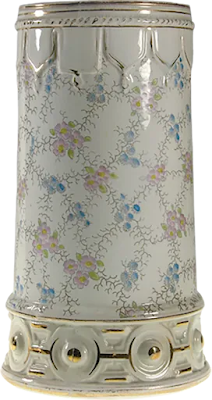| The Etruscan Baseball pitcher in its most common colorways. |
| Wedgwood Athletic cricket and soccer pitcher in Argenta |
The Etruscan pitcher is derived from a Wedgwood jug. The Wedgwood Athletic jug was introduced around 1872 as part of the company's Argenta line. One side of the jug features two figures playing cricket while the other side shows two figures playing soccer. The Etruscan version is a pretty faithful rendition of the Wedgwood original with one exception. As cricket was not played in the U.S., the cricket players on the one side of the Wedgwood jug were replaced by baseball players. Baseball was a growing popular sport in the U.S. The Etruscan Works itself had its own baseball team, the Etruscans, who played games against teams from local businesses.
The Wedgwood original on the left with the Etruscan version on the right
The Etruscan Baseball pitcher was made in three different sizes with the largest being the most common. There were also five different variations of the jug made: one with the baseball player on the right side of the handle and the soccer players on the left; one with the soccer players on the right side of the handle and the baseball players on the left; one with the baseball players on both sides of the pitcher with no soccer players; one with only soccer players on both sides; and one version with both baseball players and soccer players with an enlarged spout.
Etruscan Baseball pitcher from the 1884
Etruscan Majolica catalog
Baseball pitcher from the 1884
Etruscan Ivory Ware catalog
There are four glazing treatments used that I am familiar with. The most commonly found multicolor treatment is a copy of the Wedgwood Argenta original: white ground with green, grey and rose trim and multicolor figures. Less commonly seen is a red ground with green, grey and rose trim and figures in colors of grey, blue and brown.
The pitcher was also decorated using the over-the-glaze Venicine enamel treatment as well as the Ivory Ware method. These jugs were made from traditional earthenware, as were all the others, and marked with the Etruscan Majolica stamp.
| Etruscan Baseball pitcher with rare red ground |
| Etruscan Baseball pitcher in the large spout variation |
The pitcher was also decorated using the over-the-glaze Venicine enamel treatment as well as the Ivory Ware method. These jugs were made from traditional earthenware, as were all the others, and marked with the Etruscan Majolica stamp.
Etruscan Baseball jug in Venicine
|
| Solid color Baseball jug |
In addition to these variations of the baseball pitchers adapted from the Wedgwood jug, the basic design for the jug was also adapted for other uses without figures. The company used the design for vases, tumblers, and umbrella stands with solid colored grounds and gold banding or decorated with transfers. The same design was also elongated and the spout enlarged for a tall cider jug. None of these are ever marked.
| Etruscan vase with transfer decoration |
Phoenix Pottery umbrella stand
| Phoenix Pottery banded cider pitcher |
| Phoenix Pottery banded tumbler |
| McKinley campaign picher based on the Wedgwood model |
We don't know when production of the Baseball pitcher stopped but our guess is that it was sometime after David Smith left the Chester Pottery in 1885. The other pieces derived from the Wedgwood pitcher –umbrella stand, the cider pitcher, tumbler, vase and plain pitcher– continued in production for several years until the closing of the Chester pottery in 1899. It is believed that all majolica production ceased at this time.
Today the baseball pitcher is still one of the most popular pieces made by the company. Even in its unmarked, solid color variation it continues to command good prices in the collector's market.
*This post has been updated

















Great research as always. You always manage to unearth new facts and never before seen pieces - well done! Now, how about figuring out the makers of the German majolica animal liquor bottles HB and B&L? Haven't found and have tried for years!
ReplyDeleteMany thanks!
Delete